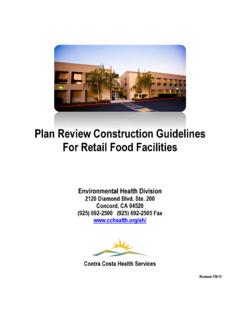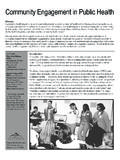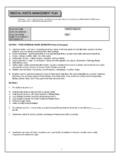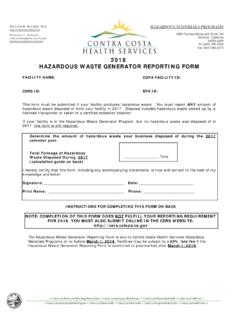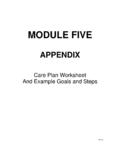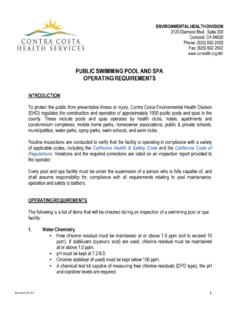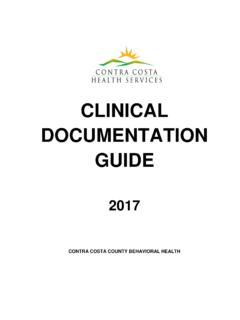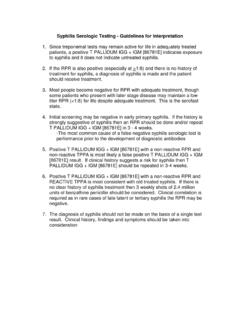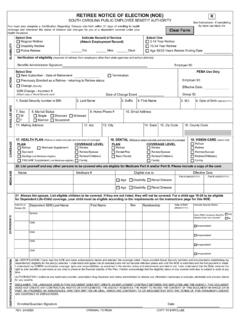Transcription of Adults Needs and Strengths Assessment (ANSA) - Contra …
1 Praed Foundation 550 N Kingsbury St, Chicago, IL 60654 W Contra Costa Behavioral Health Services Adults Needs and Strengths Assessment (ANSA) Ages 21+ Praed Foundation 1999, 2016, 2020 2020 REFERENCE GUIDE Contra Costa Behavioral Health Services Adult Needs and Strengths Assessment (ANSA) 2 ACKNOWLEDGEMENTS A large number of individuals have collaborated in the development of the Adult Needs and Strengths Assessment . Along with the CANS versions for developmental disabilities, juvenile justice, and child welfare, this information integration tool is designed to support individual case planning and the planning and evaluation of service systems. The ANSA is an open domain tool for use in multiple individual-serving systems that address the Needs and Strengths of individuals, adolescents, and their families.
2 The copyright is held by the Praed Foundation to ensure that it remains free to use. Training and annual certification is expected for appropriate use. We are committed to creating a diverse and inclusive environment. It is important to consider how we are precisely and inclusively using individual words. As such, this reference guide uses the gender-neutral pronouns they/them/themselves in the place of he/him/himself and she/her/herself. This manual is adapted from the Standard ANSA Comprehensive Reference Guide developed by the Praed Foundation (1999, 2017) after review by multiple staff from Contra Costa Behavioral Health Services Division (CCBHSD). The version of the ANSA used by CCBHSD was selected by the Contra Costa Behavioral Health Services Division s ANSA Implementation Team a multidisciplinary planning body to ensure quality care.
3 For specific permission to use please contact the Praed Foundation. For more information on the ANSA contact: John S. Lyons, PhD Director Center for Innovation in Population Health Professor, Health, Management & Policy University of Kentucky College of Public Health April D. Fernando Associate Director, Workforce Development Center for Innovation in Population Health Assistant Professor, Health, Behavior & Society University of Kentucky College of Public Health Praed Foundation Claire Battis Contra Costa Behavioral Health Services Planner/Evaluator Contra Costa Behavioral Health Services Adult Needs and Strengths Assessment (ANSA) 3 TABLE OF CONTENTS ACKNOWLEDGEMENTS .. 2 INTRODUCTION .. 4 The ANSA .. 4 Six Key Principles of the ANSA.
4 4 History and Background of the ANSA .. 4 History .. 5 Measurement Properties .. 5 Rating Needs & Strengths .. 6 How is the ANSA Used? .. 7 It is an Assessment Strategy .. 7 It Guides Care and Treatment/Service Planning .. 8 It Facilitates Outcomes Measurement .. 8 It is a Communication Tool .. 8 ANSA: A Strategy for Change .. 8 Making the Best use of the ANSA .. 8 Listening Using the ANSA .. 9 Redirect the Conversation to One s Own Feelings and Observations .. 9 Acknowledge Feelings .. 9 Wrapping it Up .. 9 REFERENCES .. 11 Contra Costa County ANSA Basic Structure .. 12 Core Items .. 12 Strengths DOMAIN .. 13 LIFE FUNCTIONING DOMAIN .. 20 [A] Health Module .. 26 RISK BEHAVIORS DOMAIN .. 33 [B] Dangerousness Module .. 35 [C] Crime Behavior Module.
5 40 CULTURAL FACTORS DOMAIN .. 45 BEHAVIORAL/EMOTIONAL Needs DOMAIN .. 48 [D] Trauma Module .. 55 [E] Substance Use Disorder Module .. 59 CAREGIVER RESOURCES & Needs DOMAIN (Optional) .. 62 ADULT PROTECTION DOMAIN (Optional) .. 67 [F] Older Adult Module .. 70 Contra Costa Behavioral Health Services Adult Needs and Strengths Assessment (ANSA) 4 INTRODUCTION THE ANSA The ANSA is a multiple purpose information integration tool that is designed to be the output of an Assessment The purpose of the ANSA is to accurately represent the shared vision of the individual serving system individuals and families. As such, completion of the ANSA is accomplished in order to allow for the effective communication of this shared vision for use at all levels of the system.
6 Since its primary purpose is communication, the ANSA is designed based on communication theory rather than using psychometric theories that have influenced most measurement development. There are six key principles of a communimetric measure that apply to understanding the ANSA. SIX KEY PRINCIPLES OF THE ANSA 1. Items were selected because they are each relevant to service/treatment planning. An item exists because it might lead you down a different pathway in terms of planning actions. 2. Each item uses a 4-level rating system designed to translate immediately into action levels. Different action levels exist for Needs and Strengths . For a description of these action levels please see below. 3. Rating should describe the individual, not the individual in services.
7 If an intervention is present that is masking a need but must stay in place, this should be factored into the rating consideration and would result in a rating of an actionable need ( 2 or 3 ). 4. Culture and development should be considered prior to establishing the action levels. Cultural sensitivity involves considering whether cultural factors are influencing the expression of Needs and Strengths . Ratings should be completed considering the individual s developmental and/or chronological age depending on the item. In other words, anger control is not relevant for a very young child but would be for an older child or young adult regardless of developmental age. Alternatively, school achievement should be considered within the framework of expectations based on the individual s developmental age.
8 5. The ratings are generally agnostic as to etiology. In other words this is a descriptive tool; it is about the what not the why. While most items are purely descriptive, there are a few items that consider cause and effect; see individual item descriptions for details on when the why is considered in rating these items. 6. A 30-day window is used for ratings in order to make sure assessments stay fresh and relevant to the individual s present circumstances. However, the action levels can be used to over-ride the 30-day rating period. HISTORY AND BACKGROUND OF THE ANSA The Adult Needs and Strengths Assessment is a multi-purpose tool developed to support care planning and level of care decision-making, to facilitate quality improvement initiatives, and to allow for the monitoring of outcomes of services.
9 The ANSA was developed from a communication perspective in order to facilitate the linkage between the Assessment process and the design of individualized service plans including the application of evidence-based practices. The ANSA gathers information on individuals and parents/caregivers (if relevant) Needs and Strengths . Strengths are the individual s assets: areas in life where they are doing well or have an interest or ability. Needs are areas where an individual requires help or serious intervention. Care providers use an Assessment process to get to know the individuals and their families with whom they work and to understand their Strengths and Needs . The ANSA helps care providers decide which of an individual s Needs are the most important to address in a treatment or service plan.
10 The ANSA also helps identify Strengths , which can be the basis of a treatment or service plan. By working with the individual and family during the Assessment process and talking together about the ANSA, care providers can 1 At CCBHS, for clients only receiving medication support the ANSA-Brief is completed. Contra Costa Behavioral Health Services Adult Needs and Strengths Assessment (ANSA) 5 develop a treatment or service plan that addresses an individual s Strengths and Needs while building strong engagement. The ANSA is made of domains that focus on various areas in an individual s life, and each domain is made up of a group of specific items. There are domains that address how the individual functions in everyday life, on specific emotional or behavioral concerns, on risk behaviors, on Strengths and on skills needed to grow and develop.
